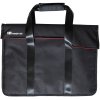The Faraday cage, named after the English physicist Michael Faraday, was introduced in of the previous articles. It is a device designed to protect people or equipment from electric fields. It uses an enclosed metal structure that blocks the electric field and prevents it from affecting objects inside the cage. The Faraday cage is used in many areas of science, technology and everyday life. Some examples of applications will be given in the following paragraphs.
Protection of electronics against electromagnetic radiation
Nowadays, when data transmissions and sensitive electronics are increasingly vulnerable to electromagnetic fields, the Faraday cage is commonly used to protect electronic devices. For example, special rooms equipped with Faraday cages are used in laboratories and research facilities to protect electronics from interfering signals. These cages are often made of copper or aluminium mesh and are designed to prevent electromagnetic interference, which is particularly important for research on sensitive devices that need an environment free from external interference. Another similar example would be large data centres where huge amounts of sensitive information are stored. Servers can be protected by a Faraday cage to prevent unwanted electromagnetic interference or attacks that could cause damage to electronics or, in the worse case, data loss.
Cable shielding
Shielded cables are another typical example of the use of Faraday cages in practice. These cables are designed to protect the transmitted signal from various forms of electromagnetic interference. Each shielded cable consists of one or more insulated conductors that are used to transmit the signal. However, the signal can be affected by external electromagnetic fields, which can cause interference and degrade the quality of the transmission. To prevent interference, the conductors are wrapped with a conductive layer that serves as a shield. This layer can be made up of various materials, such as stranded copper wires, copper strips, coated foil or even conductive polymer. In addition to protecting against external interference, shielding also works in the opposite direction - it limits the amount of electromagnetic radiation that the cable itself emits into the environment. This is important in situations where it is necessary to prevent cables from interfering with other electronic equipment in their vicinity.
Lightning protection for aircraft
One important example of the use of the Faraday cage is the protection of aircraft. During flight, aircraft are often at risk of being struck by lightning. Due to the construction of aircraft, which are made of conductive materials, their fuselage acts as a Faraday cage. This means that when lightning strikes the aircraft, the electrical current spreads across the surface of the fuselage and does not reach the interior, protecting not only the passengers but also the electronics inside.
Microwave ovens
The Faraday cage is not only used in large technological devices, but can also be found in common household appliances such as microwave ovens. Microwave ovens use electromagnetic radiation to heat food. The electromagnetic field generated inside the microwave oven interacts with the water molecules contained in the food. These molecules begin to move and rub against each other, generating heat that heats the food. The inner walls of the microwave oven are then made of metal, which can effectively block the electromagnetic field. On the door of the microwave oven we find a special metal mesh. Although this mesh allows you to see inside, it still acts as an effective barrier to prevent microwave radiation from escaping outside. Due to the design of the microwave oven, the generated electromagnetic field remains inside the device and does not penetrate outside, protecting the surrounding environment from harmful radiation. Without this protection, it would not be safe to stand next to the microwave oven during operation, as microwave radiation could damage human tissue or interfere with the operation of nearby electronic equipment.
Blocking mobile signals and Wi-Fi
Another useful application of the Faraday cage is blocking radio frequencies such as cellular signals and Wi-Fi. Specially designed rooms, boxes or cell phone bags can be used where there is a need for privacy, data protection or restrictions on electronic communications. Such rooms are used, for example, in military installations where it is necessary to prevent eavesdropping or interference with signals. There are also Faraday bags for mobile phones to block any reception or transmission of signals. They are used, for example, in sensitive business meetings to prevent surveillance and eavesdropping. Faraday bags with unrivalled attenuation can also be purchased on our e-shop here.
Conclusion
The Faraday cage, whether it is a simple metal mesh or a sophisticated protective room, is of immense importance in many areas of our lives. It protects our electronics from electromagnetic radiation, ensures the safety of passengers on planes, protects data in servers and helps protect against potential electromagnetic attacks. Thanks to its simplicity and efficiency, the Faraday cage will continue to play a key role in the world of technology.









